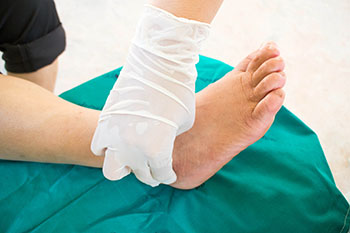
A foot wound starts when the skin and tissue are harmed, commonly due to a cut or abrasion. Although minor cuts usually heal without issue for people in good health, individuals with diabetes face a greater risk. For them, even the slightest skin damage can quickly worsen into a serious wound if not treated promptly.
Why Wounds Are Troublesome for Diabetics
Diabetes often induces complications like nerve damage and circulatory issues. Nerve damage may make it challenging for individuals with diabetes to notice a forming wound, while poor blood circulation can slow down the body's healing process. Without proper attention, these wounds can escalate into diabetic foot ulcers, which are wounds that struggle to heal. If left untreated, these ulcers can worsen, spread, get infected, and may even require amputation.
Other Causes of Foot Wounds
Foot wounds are often linked to diabetes, but they can also stem from vascular disease, circulatory issues, foot deformities, trauma, or continual irritation or pressure from footwear. While diabetes remains a primary cause of foot wounds, various other factors can contribute to their development, highlighting the importance of proper foot care and regular podiatry check-ups.
Symptoms and Prevention of Foot Wounds
Preventing foot wounds and ulcers is crucial, particularly for diabetic patients. The focus should be on proactive measures such as regular foot care, monitoring for any signs of wounds, and managing diabetes effectively. By prioritizing prevention, individuals can avoid the complications associated with foot wounds and ulcers, ultimately leading to better foot health and overall well-being.
- Daily inspections: Check your feet and ankles daily for any abnormalities. If you notice anything unusual, have it examined promptly by a podiatrist to prevent it from progressing into a wound. If you already have a wound and observe signs like redness, drainage, swelling, a foul odor, pain, or red streaks, seek immediate attention from a podiatrist. Acting swiftly can help prevent complications and promote quicker healing.
- Proper Footwear: Wear well-fitting footwear to protect your feet. Shoes should provide enough space in the toe area and give proper support to your arches and heels. Check that shoes and socks don't have any rough edges or seams that might cause irritation. Avoid wearing socks that are too tight around the ankles, as this could affect circulation. And remember, it's best to avoid walking barefoot to minimize the risk of injury.
- Proper Toenail Maintenance: Maintain toenail health for overall foot wellness. When trimming, ensure toenails are cut straight across and level with the tips of your toes. Avoid cutting them too short or in a curved shape, as this could cause ingrown toenails to develop.
- Avoid Home Care: Avoid self-treating corns, calluses, or ingrown toenails at home.
- Healthy Lifestyle: Maintain your health by keeping an eye on blood sugar levels, steering clear of smoking, and managing weight through a balanced diet and regular exercise.
Foot Wound Diagnosis and Treatment
A podiatrist focusing on wound care employs diverse strategies to treat foot wounds and expedite the healing process. Here are some of the methods they may use:
- Off-loading: Involves using therapeutic footwear, custom orthotics, and specialized foot casts to reduce pressure on wounds.
- Debridement: A method used to remove bacterial growth, foreign debris, and dead tissue from wounds, helping to enhance the healing process.
- Dressings: Podiatrists offer patients guidance and supplies to ensure wounds are kept clean and dressed appropriately at all times.
- Medications: If a wound gets infected, the podiatrist may prescribe both oral and topical antibiotics to treat it.
- Skin Grafting: This technique could be considered for extensive wounds. In this procedure, skin grafts made from the patient's skin or synthetic/animal tissue are applied to cover the wound. This stimulates healing, prevents infection, and helps minimize scar tissue formation.
For high-risk patients, regular appointments with the podiatrist are advised. During these visits, the podiatrist conducts thorough foot examinations, assesses for conditions like peripheral arterial disease and neuropathy, and offers advice on footwear and other preventive measures to avoid wounds.

